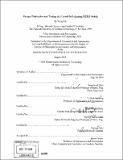Design, fabrication and testing of a lateral self-cleaning MEMS switch
Author(s)
Shi, Yong, 1965-
DownloadFull printable version (14.04Mb)
Alternative title
Design, fabrication and testing of a lateral self-cleaning microelectromechanical systems switch
Other Contributors
Massachusetts Institute of Technology. Dept. of Aeronautics and Astronautics.
Advisor
Sang-Gook Kim.
Terms of use
Metadata
Show full item recordAbstract
A lateral contact MEMS switch has been developed to address the need for a long life cycle, low contact resistance RF switch. At the present time, there is no commercial MEMS switch that meets all the requirements. The objectives of this research are to understand the functional requirements and the failure modes of such MEMS switches, and to develop a cost effective, compact and highly reliable direct contact MEMS switch.Major switch performance parameters were investigated to determine the real functional requirements of an RF switch, which leads to a novel switch design. This switch design is characterized by the self-alignment of the contact surfaces, self-cleaning of the particles generated from asperity fracture and deformation, and the anchoring method of the metal contacts in the micro switch structures and the large stroke piezo-actuation by the strain amplifying MEMS mechanism. The analytical model for the contact force - contact resistance relation is established to predict the required contact force, while modeling of the switch isolation provides the required displacement of the actuator.The 5-mask fabrication process for the device consists of several steps including bottom electrode lift-off, plating mold formation, electroplating, mold removal, switch structure formation and device release. The major issue is the fabrication of the vertical sidewall of gold for electrical contact. A fine control of electroplating current and temperature makes deep and clean vertical metal walls. The device is released with XeF₂.It has been demonstrated that a contact resistance lower than 0.1 [omega] is achieved for up to 10 billion operating cycles. The grooved surface exhibited the self-cleaning effect and the parallel-beam design of the switch structure guaranteed the perfect contact during the switch operation. In addition, no failure has been observed in the anchoring of the gold metal to the switch structure. Finally, molded electroplating proved to be an effective way to create vertical metal sidewall for electric contact. The electroplated gold surface is more uniform and the microstructure is denser than that deposited by e-beam evaporation.
Description
Thesis (Ph. D.)--Massachusetts Institute of Technology, Dept. of Aeronautics and Astronautics, 2004. Includes bibliographical references (leaves [129]-133).
Date issued
2004Department
Massachusetts Institute of Technology. Department of Aeronautics and AstronauticsPublisher
Massachusetts Institute of Technology
Keywords
Aeronautics and Astronautics.